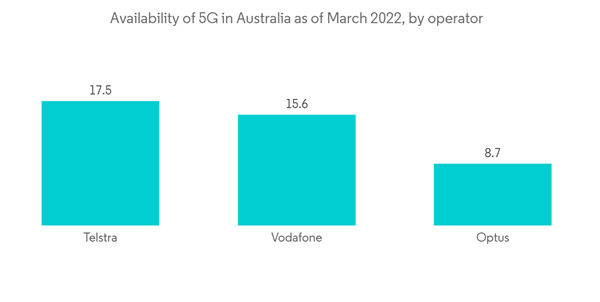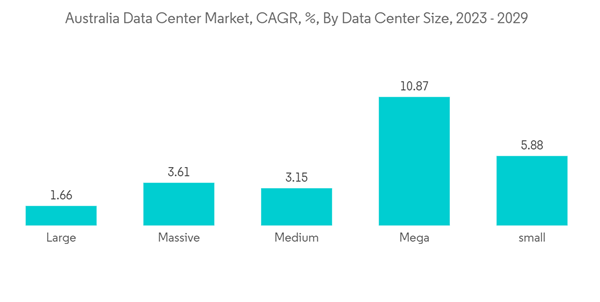Key Highlights
- The IT load capacity in the country is expected to reach over 3,000 MW by 2029, positively impacting the demand for racks in the forecast period.
- The construction of a raised floor area for data centers in the country is expected to reach 11.4 million sq. ft by 2029.
- The country's total number of racks to be installed is expected to reach over 550,000 units by 2029.
- Currently, four submarine cable projects are under construction in the country. One such submarine cable, estimated to start service in 2025, is Asia Connect Cable-1 (ACC-1), stretching over Asia Connect Cable-1 (ACC-1) kilometers with landing points Asia Connect Cable-1 (ACC-1) for planned submarine cables.
Australia Data Center Rack Market Trends
Telecom is Anticipated to Hold the Highest Market Share
- The Australian telecommunications industry is witnessing significant change. The telecom industry in Australia consists of three major carriers and an infrastructure provider, the National Broadband Network (NBN), which provides fiber and fixed-line networks. Vendors mounting their technology on the towers are Telstra, Optus, and TPG, formerly known as VHA, plus NBN.
- Currently, Australia has deployed 5G in major cities and is in the process of auctioning off the spectrum to provide more services. This will increase the need for towers. In April 2021, the government allocated a high band 5G spectrum (in the 26 GHz band), which will enable extremely fast, high-capacity services. In the second half of 2021, the government allocated a low band 5G spectrum (in the 850/900 MHz band), which will be crucial for ensuring broader geographic coverage of 5G services. This will enable new applications for 5G in the enterprise market that take advantage of 5G's unique properties like ultra-low latency, high capacity, and advanced functions like network slicing.
- In 2022, the availability of 5G in Australia increased through famous telecom players like Telstra, Vodafone, and Optus. According to OpenSignal, Telstra had the highest 5G availability of the operators. Telstra customers with a 5 G-enabled device could obtain a 5G connection 17.5 percent of the time, whereas Optus customers could only connect 8.7 percent of the time.
- In line with recent investments and acquisitions, the telecom segment of the Australian data center market is expected to grow. In June 2022, OMERS Infrastructure, which recently acquired the telecommunication tower assets of TPG Telecom, is making another tower investment in Australia. OMERS Infrastructure announced that it had agreed to buy Stilmark, a developer, owner, and operator of mobile tower assets. The consolidated towers business will also be part of OMERS Infrastructure's global portfolio of digital infrastructure assets. The telecom segment of the Australian data centers market is expected to grow significantly in order to meet the growing demand and increase dependency on data centers.
Full Rack has Majority Market Share
- In Australia, due to growing space scarcity between various companies, the full rack has a majority of the market share. In order to cope with increasing rack capacity due to the rapid growth of mobile broadband and the increase in Big Data Analytics combined with cloud computing, it is necessary to build a fully rack-equipped data center.
- Companies increasingly rely on data centers for efficient management of their databases and storage, as they generate significant amounts of data every day. The main driving factor for data center rack usage is, therefore, the increased deployment of fully configured data centers. Also, the growth of the market is being influenced by the growing demand for IT services and investments made by large companies.
- At first, there was a limited focus on rack space in data centers; only size and cost were taken into account during deployment. Nevertheless, there is an opportunity for increased use of rack space in the data center as more and more users from different sectors, such as online banking, telecommunications, media and entertainment, and others, are adopting applications with higher density.
- Mega and massive data centers are expected to have major construction during the forecast period. The lower growth is for the small and medium DC type, as the trend for hyperscale DC is adding its various benefits, such as Workload being balanced across servers and maximizing cooling efficiency. In terms of investment, NEXTDC officially opened its largest data center, an AUD 1.5 billion (USD 964200) Melbourne facility M3. This covers an area of more than 100,000 square meters. M3 will offer 150MW of necessary power for technological services as well as critical infrastructure for Australia's digital economy.
- Further, CDC now operates 13 data centers over six campuses in Canberra, Sydney, and Auckland, second Zealand, with a second CDC campus in Melbourne under construction. In 2023, the company expects to expand to 20 data centers across seven campuses and explore new countries. Such developments create opportunities for the vendors studied in the market.
Australia Data Center Rack Industry Overview
The Australian Data Center Rack Market is fairly consolidated with significant players such as Rittal GMBH & Co.KG, Schneider Electric SE, Legrand SA, Dell Inc., and Hewlett Packard Enterprise.Additional Benefits:
- The market estimate (ME) sheet in Excel format
- 3 months of analyst support
This product will be delivered within 2 business days.
Table of Contents
Methodology

LOADING...










